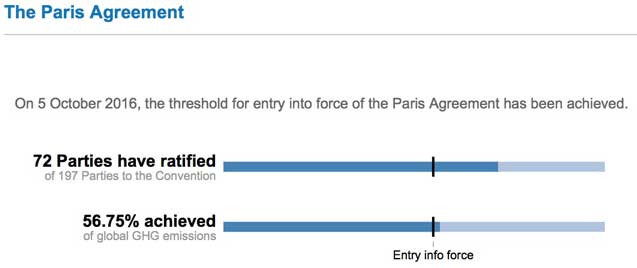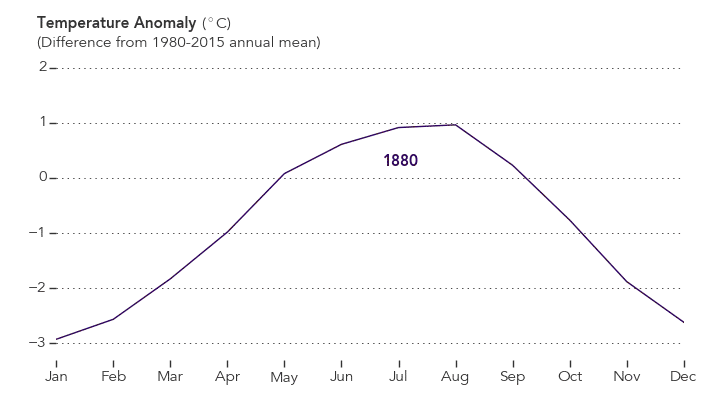 Back in December 2015 as many as 174 nations signed what is now known as the Paris Agreement on Climate Change, but that is simply ink on paper and is quite frankly meaningless in that it did not commit anybody to do anything. The far more important aspect is that it marked a beginning of a meaningful and legally binding commitment.
Back in December 2015 as many as 174 nations signed what is now known as the Paris Agreement on Climate Change, but that is simply ink on paper and is quite frankly meaningless in that it did not commit anybody to do anything. The far more important aspect is that it marked a beginning of a meaningful and legally binding commitment.
As outlined within article 21 of the agreement …
the Agreement shall enter into force on the thirtieth day after the date on which at least 55 Parties to the Convention accounting in total for at least an estimated 55 per cent of the total global greenhouse gas emissions have deposited their instruments of ratification, acceptance, approval or accession.
What the heck does “deposited their instruments of ratification” actually mean?
It means that a nation state that signed has now passed laws that legally binds it to adhering to the agreement, and that it is no longer wishful thinking, but instead is truly meaningful because they now have to actually reduce their greenhouse gas emissions.
It was thought at the time that getting to that position would take years, but the big news is that we are there, we reached that point yesterday (5th Oct). With the addition of the legally binding commitment by the EU we have met all the conditions laid out within article 21. The current EU president commented …
“The entry into force of the Paris agreement less than one year after its signature is a massive achievement, given that it took eight years for the Kyoto protocol,” – European Parliament President Martin Schulz
Officially it enters into force on the thirtieth day after the two conditions were met, hence that will be 30 days after yesterday, Wed 5th Oct.
What Happens now?
There will be a CMA to oversee the tracking and monitoring of the NDCs.
The what will track and monitor what?
OK, let’s take this step by step. Once the tipping point is reached (as highlighted above), there will be a formal conference of the nations that agreed to it all. That conference will track and monitor everything to ensure that nations stick to what they have agreed to. They will also be seeking even greater commitments, as part of the five year review, so this is just the beginning.
CMA = Conference of the Parties serving as the meeting of the Parties to the Paris Agreement
NDC = Nationally Determined Contributions – Each nation has committed itself to make a specific reduction of greenhouse gases. Article 4 of the Paris Agreement established an official registry of these NDCs for each nation
It all works like this because that is what was agreed. Once the Paris Agreement formally enters into force (as defined in Article 21 of the agreement), Article 16, paragraphs 1 and 2, passes full responsibility for tracking, monitoring, and managing the policing of these NDCs to what is being called the CMA. This is basically where the nations that have agreed all this get together in a formal meeting and manage the oversight of it all.
OK, so when exactly will CMA 1, the 1st CMA session, actually happen?
Article 16, paragraph 6 of the Paris Agreement covers that. It states that CMA 1 shall be convened by the secretariat (of the UN) in conjunction with the first session of the COP scheduled after the date of entry into force of the Agreement.
[Sigh!], yes, we are still swimming in alphabet soup. OK, so what is COP?
COP = Conference of the Parties … basically, this is the UN body that gets together to talk about dealing with Climate Change
So how does this actually play out then?
Since the next COP meeting (known as COP 22) is scheduled for 6th November in Marrakech, and the 30 day rule exists within the Paris agreement (that article 21 bit), then the date by which at least 55 nations accounting for at least 55% of global greenhouse gases needed to ratify the agreement was this Friday 7th Oct. Since we just made it yesterday on 5th Oct, that now enabled CMA 1 to be convened in conjunction with COP 22 in Marrakech next month. If we had missed that Friday deadline tomorrow, then formally they would have had to wait an entire year, Nov 2017, for the first CMA 1 meeting.
This was the easy bit, and so now the really hard work begins. We start with the first step and then take the next and the next after that.
Quick Reminder
Here is what has been happening …

We don’t have the official numbers yet, but September 2016 looks like it was the hottest September ever recorded.
Overall, 2016 is on track to be the hottest year on record by a significant margin.
Doing nothing is not an option. In fact, ever the currently agreed Paris Agreement is not at all enough, but it is an important first step.